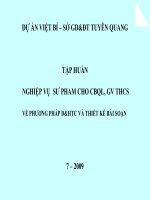Tập huấn hè 4
Bạn đang xem bản rút gọn của tài liệu. Xem và tải ngay bản đầy đủ của tài liệu tại đây (110.73 KB, 25 trang )
TEACHING READING
Presented by
QUESTIONS FOR DISCUSSION
I. Reading skills and strategies
II. Principles behind the teaching of reading.
III. Guidelines for teaching reading
IV. Follow-up activity
Choose a text in Tieng Anh 12 nang cao
and design a lesson plan.
I. Reading skills and strategies
1. Scanning: Students read the text in order
to find some specific information. When
reading, they do not have to read every
word and line.
e.g. instructions on how to find a house
2. Skimming: Students read the text quickly
in order to get the gist or the general idea
or global meaning.
e.g. reading a magazine article
3. Reading for detailed comprehension:
Students read the text and try to get all the
details, concentrating hard on specifics.
e.g. instructions on how to find a house
4. Predicting: Students predict what the text is
about before reading and continuing to
predict what will come next while reading.
5. Guessing: Students guess the meaning of
unknown words from the context.
6. Using a dictionary: Students use
dictionaries (both monolingual and
bilingual) to look up new words to facilitate
reading.
7. Inferring: Students read the text and try to
work out the writer’s opinions, implications,
and attitudes.
II. Principles behind the teaching of
reading.
Principle 1: Reading is not a passive kill. It is an
incredibly active activity. Both teachers and
students must understand the meanings of words,
the arguments and work out if they agree with each
other. If not doing so, they only scratch the surface
of the text and quickly forget it.
Principle 2: Students need to engaged with what
they are reading. If they are not interested in
reading the text, they cannot benefit much from the
text.
II. Principles behind the teaching of
reading (continued)
Principle 3: Students should be encouraged
to respond to the content of a reading text,
not just to the language. The meaning, the
message of the text is important so teachers
should give students an opportunity to
respond to that message, to express their
feelings about the topic. This will make them
be engaged with the reading text and the
language.
II. Principles behind the teaching of
reading (continued)
Principle 4: Prediction is a major factor in
reading.The book cover, the headlines, the
photographs, the word-processed page can
be used as hints to make a student’s brain
start predicting what he/she is going to read.
Predicting what is coming will help students
become better and more engaged readers.
II. Principles behind the teaching of
reading (continued)
Principle 5: Match the task to the topic.
Teachers should choose good reading tasks for
students to read. The most exciting passage is the
one with appropriate questions, imaginative and
challenging tasks.
Principle 6: Good teachers exploit the reading text
to the full.
Teachers should integrate the reading text into
interesting class sequences, using a variety of tasks
to help students read and comprehend the text
thoroughly.
Top-down and bottom-up processing
In top-down processing, the reader gets a general
view or idea of the reading text by absorbing the
overall picture/ reviewing what he knows about the
topic to interpret the message he is reading.
In bottom-up processing, the reader focuses on
individual words, phrases or cohesive devices and
achieves understanding by stringing these detailed
elements together to build up a whole.









